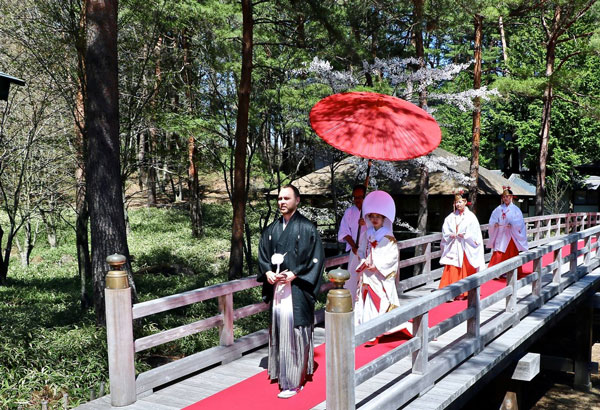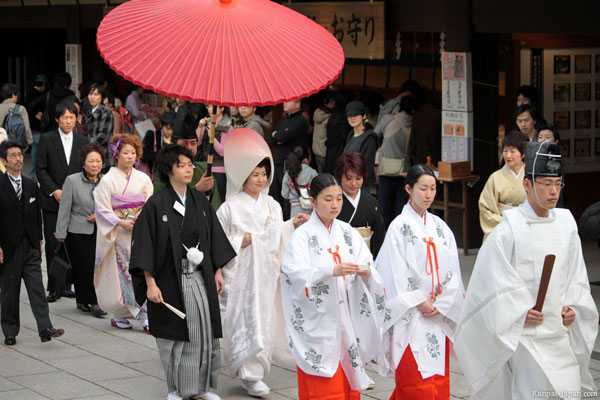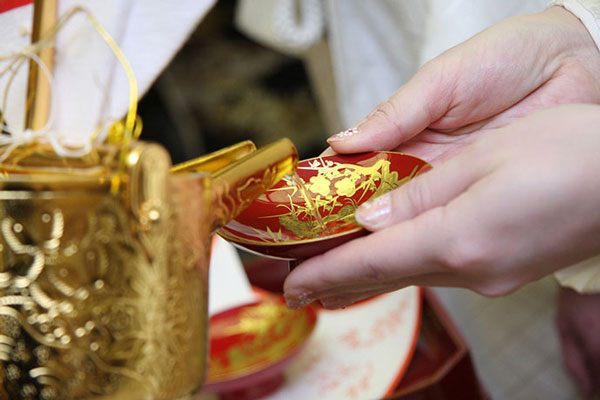…it’s safe to say this comes to mind when you think of a wedding.
However, weddings look different all over the world, and the Shinto wedding ceremony in Japan is one of the most intricate and fascinating.
Shinto History
The traditional Japanese Shinto wedding holds deep historical ties to both Japanese culture and the Shinto religion. Records of Shinto practices date to the 18th Century, in the two oldest documents that chronicle the history of Japan, known as the Kojiki and the Nihon Shoki. Eventually, the Japanese adopted the ethnic Shinto faith and embrace its ideals of emphasizing diligently carried out ritual practices to establish a connection between present day Japan and its ancient past. This central concept carries itself throughout the practices of the Shinto religion, such as language, dress, Japanese art and wedding ceremonies.

In every religion, wedding ceremonies symbolize the key values of the faith. In religions such as Christianity and Judaism, marriage rituals were set in place right at the start of the faith’s history. The Shinto wedding however, is a relatively new invention.The first time the term was recorded was in a Shinto manual in 1872, and the actual ceremonies were only reported in the 1880’s. These first Shinto wedding ceremonies were primarily held for the families of Shinto priests, and with time became small family gatherings that didn’t even hold any religious significance. So, how did these small family gatherings become a symbol of the Shinto religion?
In the 19th century, as state-sponsored Shinto shrines decreased significantly and the state of Shinto as a practiced faith declined, scholars knew that they needed to revitalize the religion. Therefore, in order to reunite the people of faith and encourage the renewed practice of Shinto rituals, many new customs and ceremonies were established.
Evolving Through Time
With time, the Shinto wedding ceremony was adapted and re-adapted to eventually reach its modern day form. 500 years ago in the Muromachi period, couples would simply enter a ‘zashiki’, or sitting room, write their names and bring offerings to the gods. The couple would then drink from the sacred sake and be married. Throughout the years, and depending on the leadership during each period, the Shinto wedding ceremony took on different forms. For example, during the Meiji period, the Emperor told his son to marry in front of where the Sun Goddess is enshrined. This made a significant shift in the rituals of the ceremony, and is still performed in a similar way today.

(Image Source: www.worriedwanderer.com)
Today, the ceremony is limited to a small gathering of the couple’s immediate family members. Friends and additional family join the bride and groom for a reception after the ceremony.
The Twelve Steps
There are 12 total steps to the Shinto wedding ceremony, each keeping the main focus of standing before the gods and declaring your dedication of love. The bride is dressed in “shiromuku” and “irouchikake, the traditional kimono for women. The shiromuku is worn throughout the ceremony itself, and is an all-white kimono – to symbolize purity. While the irouchikake is a colorful kimono designated for the after party. The groom is dressed in his traditional “montsuki haori hakama’ attire with his family crest placed on the “haori”, which is a thin over coat. The bride wears white socks and traditional Japanese shoes known as ‘geta’, which are a combination of clogs and flip flops.
The intricate ceremonial steps are:
Step One: SANSHIN-NO-GI (The Procession Ceremony):
The bride and groom, with their guests and Shinto priests, are lead to the shrine by a shrine maiden. It is customary to hire musicians to play on traditional Japanese flutes as the procession takes place. In this step, the couple is preparing to stand and be presented to the gods as they declare their love for one another.

(Image Source: www.kanpai-japan.com)
Step Two: NYUJO (Entrance to the Shrine):
In this step, the guests enter the shrine in the order of family proximity to the couple. The bride’s family sit to the left, while the groom’s family are seated to the right. The couple follows after their families and is still led by the Shinto Maiden.
Step Three: SHUBATSU-NO-GI (The Purification Ceremony):
This step may be the most important, as purification before the gods is the core of the Shinto wedding. Before the actual ceremony begins, a Shinto priest purifies the bride, groom and guests. Some say that the gods know that people sin throughout each day without realizing, and for the couple to begin their journey together, they must be purified from all of their sins.
Step Four: NORITO-SOJO (Shinto Ritual Prayer Reading):
The Shinto priest reads out a ritual prayer that announces the marriage to the divinities. This ritual prayer is called the “Norito” and it declares that the bride and groom are marrying while promising their eternal happiness together. The priest also asks for protection and blessings over the couple. The guests then stand and bow.
 Step Five: SANKON-NO-GI(The Exchange of the Cups):
Step Five: SANKON-NO-GI(The Exchange of the Cups):
Now that the bride and groom have had their union declared and recognized, they exchange three cups of sacred sake. Each time the bride and groom take a cup, they must sip from it three times.
This ritual is named ‘San-San-Kudo’, which literally translates to three, three, nine, after the three sips of wine, from three separate cups, totaling nine sips altogether. It is believed this ritual has so much power that the sip of sacred sake brings blessings from the gods.
Step Six: KAGURA HŌNŌ (Dedication to the Sacred Dance):
Shinto maidens then perform an ancient Shinto dance as an offering to the gods to receive a blessing for the couple and their families.

(Image Source: www.japan-magazine.jnto.go.jp)
Step Seven: SEISHI SOJO (The Reading of the Vows):
The bride and groom walk towards the altar, and the groom recites the marriage vow. Although the groom is the one to read out the vows, the bride adds her name to it, making it a joint promise.
Step Eight: TAMAGUSHI HOTEN (The Tamagushi Offerings):
The bride and groom then bring a Tamagushi (a sasaki branch of Japanese Cleyera) decorated with cotton thread. A Tamagushi symbolizes the candor from the people to the gods. It is then customary for the bride and groom to bow twice, clap their hands twice, and then bow one more time to show their gratitude to the gods.
Step Nine: YUBIWA-NO-GI (Exchange of the Rings):
The bride and groom now exchange rings and place them on their hands.
Step Ten: SHINZOKUSAKAZUKI-NO-GI (The Drinking of Sacred Wine With the Wedding Participants):
As the marriage symbolizes not only the binding of the bride and groom, but also of their families, the guests present take three sips of the sacred wine–bounding them together as one family.
Step Eleven: SAISHU AISATSU (Greetings by the Shinto Priest):
The Shinto priest leads the congregants and bows, and they bow with him. At this point the families exchange words of congratulations. They bow to the gods, completing the rituals of the marriage ceremony.

(Image Source: www.thesynchronal.com)
Step Twelve: TAIJYO (The Exit):
After everyone has bowed, they may exit. It is customary for the bride and groom to have a less formal reception with a larger group of friends and family, to celebrate their marriage.
These intricate rituals with symbolic meanings, strive to keep the Shinto faith alive in Japan. Today, the number of Japanese people who identify as Shinto is around 60%, but the couples performing the ceremony is drastically decreasing. What’s more, fewer Japanese couples are getting married, and even if they decide to wed, they typically choose western-style chapel weddings instead. However, considering the deep traditions this ceremony is enriched with, it would be hard to believe that something so deep rooted in history will disappear from the world soon.
